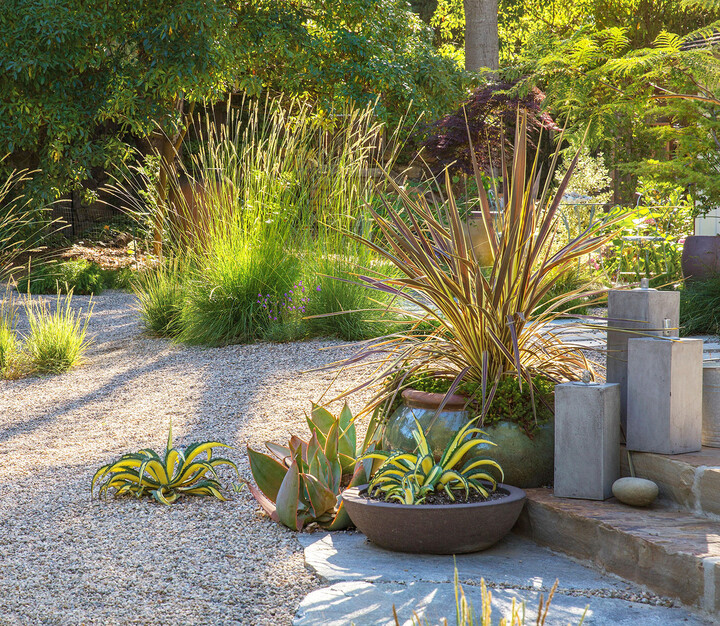Crushed rock helps connect different areas of the yard into a cohesive, calm design that's also low-maintenance.
One of landscape designer Margie Grace's favorite materials is so humble it rarely gets a second thought. "I love gravel," she says. "It feels so timeless and earthy, and you know the soil is breathing beneath it." In the yard around her and partner Dawn Close's ranch house in Montecito, California, gravel is the foundation of the design. By combining the material with airy grasses and perennials, Grace created a space that's easygoing, surprisingly soft-looking, and drought-tolerant. "I really, really wanted to crack the nut on water," Grace says. (Though her area gets little rain year-round, drought conditions can occur anywhere in the country.) "I wanted super-low water use but a lush feel."
Grace also wanted to find a way to carve the backyard, which was an expanse of drought-dead grass when she moved in, into different garden rooms. Now, gravel paths and barefoot-friendly concrete pavers wind among the mature oak trees, gently waving grasses, and structural succulents to distinct seating and dining areas. A stone patio around the house helps keep gravel from being tracked inside.
Even though Grace uses fewer plants than many designers might ("A way to use less water is to use less plant material," she says), she appreciates the particular charms of each one, like the golden grasses. "Right around 5 o'clock there's a beam of light that comes through the seed heads, and it's frickin' magic," she says. "The show is over in seven minutes, but it's worth organizing your day around."
The majority of Grace's garden relies on foliage, but she plants a handful of water-wise flowers for color. She especially likes bright orange California poppies, which reseed themselves each year, mixed with fern leaf lavender. (Get a similar look with other garden poppies suited to your growing zone.)

The Dirt on Gravel
Gravel is a versatile element that suits a wide variety of garden styles: sleekly contemporary, casual and friendly, or Versailles-level formal. The material visually connects different areas in the yard and serves as soothing negative space. Practically, it can be used for a driveway, a walkway, or as mulch, planted (as Grace does) with unthirsty grasses. It's flexible, not particularly expensive, and less permanent than concrete.
1. Choose Harmonious Colors
Gravel comes in a range of colors, including tawny browns and cool grays. When choosing gravel, Grace brings all the materials she plans to use to make sure the colors harmonize. "I get a chunk of the paving stone I'm going to use into the back of the car," she says. She recommends crushed gravel for driveways but larger rocks, at least 3/8 inch, for areas that will have leaves blown off them.
2. Install Securely
Grace uses gravel directly on soil, although gardeners in rainier regions should use a base layer of landscape cloth to keep the gravel out of the mud. Prepare the soil by leveling and firming it. A 1/2- to 1-inch-thick layer of gravel is plenty. If you can make distinct footprints, it's too deep. Where people will walk in bare feet, use smooth concrete or stone pavers.
3. Maintain the Surface
Although it's an effective mulch, weeds can still take root in gravel. About once a month, Grace uses a stirrup hoe to dispense with them while they're young—before they go to seed. Occasional raking keeps gravel looking neat, and leaf-blowing a few times a season clears fallen leaves. Every few years, replenish spots that look thin and get a lot of traffic.